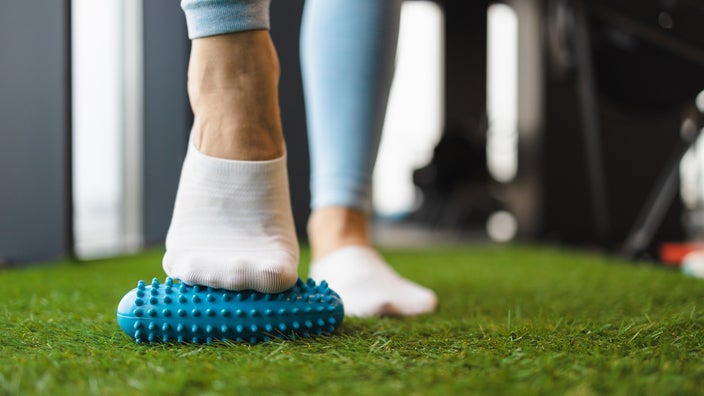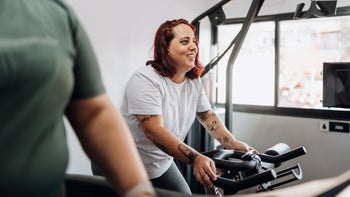
8 Heel Spur Exercises for Pain Relief
Key takeaways:
Heel spurs occur when calcium deposits build up. This leads to a bony growth on the bottom of the heel.
Not all heel spurs hurt. But they can be painful, especially when combined with plantar fasciitis.
Conservative treatment, including exercise, ice, and orthotics, can help relieve heel pain. Heel spur exercises should stretch and strengthen foot and leg muscles.
Table of contents

If you have heel pain — especially with those first few steps in the morning — you might have a heel spur. A heel spur, or plantar calcaneal spur, is a calcium deposit that forms on the heel bone. It’s often seen in those who also have plantar fasciitis.
But the two conditions are different. Heel spurs can feel like a sharp pain that goes away after walking or a dull ache that lasts all day.
Not all heel spurs cause pain, though. Some estimates suggest that only 5% of people with heel spurs have heel pain. And research shows that up to 85% of those with heel spurs will also have plantar fasciitis.
Search and compare options
The plantar fascia is a thick ligament that connects your heel to your toes. Irritation — from risk factors like age or weight — can cause microtears that may result in inflammation. It is thought that the inflammation from plantar fasciitis causes your body to build extra bone tissue, leading to a heel spur. Fortunately, simple stretching and strengthening exercises can help relieve the pain.
What exercises can help treat heel spurs?
Strengthening and stretching exercises may limit heel pain and improve walking stride. If your provider gives you the OK, try the following moves for heel spur pain. You can do them three times per day for the first month and then once a day after that.
Don’t struggle with foot pain. Learn common causes and how to treat it.
Plantar fasciitis is one of the most common types of foot pain. But what does it feel like? Find out from three people living with plantar fasciitis.
Stretches for plantar fasciitis can help ease heel pain. Try adding these stretches to your routine for relief.
1. Plantar fascia massage
According to a recent study, massaging the plantar fascia boosts circulation, eases pain, and improves flexibility.
Step 1: Stand with your hands near a wall or other surface for stability.
Step 2: Place a golf ball, a foam roller, or a water bottle under your foot.
Step 3: Roll the massage device under your foot, from your heel to your toes.
Step 4: Push down until you feel discomfort but not sharp pain.
Step 5: Roll for 45 seconds, followed by a 15-second rest.
Step 6: Repeat 5 times.
2. Seated plantar fascia stretch
This simple stretch targets the plantar fascia. It can help improve mobility and ease short- and long-term heel pain.
Step 1: Sit in a chair and cross one leg over the other, with your ankle resting on your opposite knee.
Step 2: Place one hand on your ankle, and use your other hand to pull your toes backward. You will feel a stretch along the bottom of your foot.
Step 3: Hold for 20 seconds.
Step 4: Repeat 3 times, then switch to the other foot.
3. Wall calf stretch
Stretching your calf muscle, also called the gastrocnemius-soleus complex, has been shown to limit heel pain. The wall calf stretch is a great way to target these muscles.
Step 1: Stand facing a wall. Get into a lunge position with one leg forward, slightly bent, and one leg straight behind you.
Step 2: Keep your back leg straight with your foot flat as you lean forward moving your hips toward the wall. You will feel a stretch in your calf on the leg straight behind you.
Step 3: Hold for 30 seconds, then relax.
Step 4: Repeat 2 sets of 10.
Step 5: Switch sides, and repeat steps 1 to 4 on your other leg.
Tip: You can try the downward dog yoga position for a great calf stretch that also targets your hamstrings.
Read more like this
Explore these related articles, suggested for readers like you.
4. Wall calf stretch with bent knee
This version of the wall calf stretch targets the soleus muscle in your calf.
Step 1: Stand facing a wall. Get into a lunge position with one leg forward, slightly bent, and one leg straight behind you.
Step 2: Bend your back knee slightly, stopping before your heel raises from the floor.
Step 3: Lean forward, moving your hips toward the wall.
Step 4: Hold for 30 seconds, and then relax.
Step 5: Repeat 2 sets of 10.
Step 6: Switch sides and repeat steps 1 to 6 on your other leg.
5. Heel drops
The heel drop is a strengthening exercise that can stretch your Achilles tendon and calf muscles. You can use an exercise step or practice at a set of stairs with a sturdy railing.
Step 1: Place your exercise step against a wall. Stand on the step with your back straight and your feet flat.
Step 2: Hold the wall for support. Move your right foot toward the back of the step so that the ball of your foot is on the edge of the step. Lower your right heel toward the floor.
Step 3: Keep your right knee straight and hold for 30 seconds, feeling the stretch in your right calf.
Step 4: Repeat 2-3 times before switching to the left foot.
6. Heel raises
Targeted strength-building exercises like heel raises can alleviate heel soreness and improve function. The move can double as a strengthening and stretching exercise if you add a rolled towel under your flexed toes. Doing so stretches the plantar fascia. You can also start by doing this exercise with both legs at the same time before progressing to one leg.
Step 1: Stand in front of a chair or other stable surface you can use to steady yourself.
Step 2: Put a small, rolled washcloth on the floor. Place your toes on top of the towel. The roll should be high enough that it slightly flexes your toes.
Step 3: Perform 10 heel raises on one leg. Focus on slowly lifting on your toes, pausing at the top, and slowly going down.
Step 4: Perform 2 sets of 10. Repeat on the other leg.
7. Towel scrunches or curls
Towel scrunches work all the small inner muscles in the foot.
Step 1: Sit in a chair, and place a small towel on the floor.
Step 2: Use your toes to grab the middle of the towel, and curl the towel toward you.
Step 3: Repeat 10 times.
Step 4: Rest for a minute, and repeat 10 more times.
Step 5: Switch sides, and repeat on the other foot. You can also practice towel scrunches with both feet at the same time.
8. Resisted ankle inversion
Ankle inversion exercises help you build strength in the muscles that support your ankles and feet. This move requires a resistance band.
Step 1: Sit on the floor with your legs straight in front of you.
Step 2: Tie a resistance band around one foot. Or use a band with a loop and put your foot through it.
Step 3: Cross your ankles, placing your foot with the resistance band on top.
Step 4: Loop the band under your bottom foot to give more resistance, and stabilize the band.
Step 5: Move your top foot inward, feeling the pull against the band.
Step 6: Repeat 10 times, rest, and repeat.
Step 7: Switch sides, and repeat on the other leg.
Are there other treatment options for heel spurs?
Along with exercise, these treatment options may help heel spur pain:
Ice: Rolling a frozen water bottle or placing an ice pack on your foot for 10 to 15 minutes can help relieve the pain and inflammation from a heel spur.
Orthotics or shoe inserts: Orthotics, such as heel pads or arch supports, offer shock absorption that can help.
Shockwave therapy: Extracorporeal shockwave therapy uses shockwaves to stimulate the healing of the plantar fascia. This type of treatment, specifically the focused shockwave, can give relief.
Kinesio taping: Talk to your physical therapist about using kinesiology tape, which is a flexible and stretchy tape applied in a specific pattern to your foot. Studies have shown that it is effective in limiting plantar fasciitis pain.
Injections: Cortisone injections can help lower pain and inflammation in the plantar fascia. But these are painful, and there is little high-quality evidence to support them.
Surgery: Most heel spurs improve with conservative treatment, including exercises. In rare cases, you may need surgery to remove the heel spur.
What causes heel spurs?
Some people are more prone to heel spurs than others. While some factors are outside your control, you can manage others. These factors may raise your risk of heel spurs:
Age: Your chances of developing heel spurs go up as you age, with one study revealing that 55% of people over age 62 had a heel spur. It may have something to do with a change in your gait or walking pattern as you age. This includes a shorter stride length, which can put more stress on your feet.
Genetics: Experts say that some people’s bodies naturally make more bone growth as a stress response. This can raise your risk of heel spur formation.
Gender: Women may be more likely to develop heel spurs than men, research says, and at a younger age than men. Wearing high-heeled shoes could be a significant factor.
Flat feet: People with flat feet — or little to no arch when standing — may be predisposed to painful heel spurs. But a newer study did not find this correlation, so more research is needed.
Plantar fasciitis: Those with plantar fasciitis also have a high chance of getting a heel spur. Chronic inflammation of the plantar fascia may cause the insertion point of the tissue to build up a bony deposit resulting in a bone spur.
Arthritis: When you have arthritis, joint and cartilage damage may cause your body to develop heel spurs.
Weight: Excess weight puts more stress on your feet, raising the chance of developing heel spurs.
Certain factors may also raise your chance of having a sore or painful heel spur. These include:
Size of the bone spur
Inflammation (plantar fasciitis)
Plantar fascia tears
Fractures
Nerve compression
Fat pad atrophy
Occupation and how often you stand
The bottom line
A heel spur is a bony growth that develops on the bottom of the heel bone. Many are not painful. But various factors — like having plantar fasciitis or flat feet — can raise your risk of a painful heel spur. Some people may also have a genetic predisposition to heel spurs. Conservative treatment, including exercise, ice, and orthotics, often relieves the pain. In rare cases, surgery may be needed to remove heel spurs.
Why trust our experts?



References
American Council on Exercise. (n.d.). Step stretch.
Arif, M. A., et al. (2022). Effectiveness of gastrocnemius-soleus stretching program as a therapeutic treatment of plantar fasciitis. Cureus.
AskDoctorJo. (2017). Ankle inversion with resistive band - ask Doctor Jo [video]. YouTube.
Berkson, E. M., et al. (2007). Chapter 15 - Heel pain. Core Knowledge in Orthopaedics: Foot and Ankle.
Cedars Sinai. (n.d.). Bone spurs.
Digiovanni, B. F., et al. (2006). Plantar fascia-specific stretching exercise improves outcomes in patients with chronic plantar fasciitis. A prospective clinical trial with two-year follow-up. Journal of Bone and Joint Surgery.
Irving, D. B., et al. (2007). Obesity and pronated foot type may increase the risk of chronic plantar heel pain: A matched case-control study. BMC Musculoskeletal Disorders.
Kirkpatrick, J., et al. (2017). The plantar calcaneal spur: A review of anatomy, histology, etiology and key associations. Journal of Anatomy.
Menz, H. B., et al. (2008). Plantar calcaneal spurs in older people: Longitudinal traction or vertical compression. Journal of Foot and Ankle Research.
Morrissey, D., et al. (2021). Management of plantar heel pain: A best practice guide informed by a systematic review, expert clinical reasoning and patient values. British Journal of Sports Medicine.
OrthoInfo. (2022). Plantar fasciitis and bone spurs.
Orthopedic Associates of Hartford. (n.d.). Achilles tendinitis: Home exercises.
Prichasuk, S., et al. (1994). The relationship of pes planus and calcaneal spur to plantar heel pain. Clinical Orthopedics and Related Research.
Radford, J. A., et al. (2006). Effectiveness of low-dye taping for the short-term treatment of
plantar heel pain: A randomised trial. BMC Musculoskeletal Disorders.
Ranbhor, A. R., et al. (2021). Immediate effect of foam roller on pain and ankle range of motion in patients with plantar fasciitis: A randomized controlled trial. Hong Kong Physiotherapy Journal.
Rathleff, M. S., et al. (2015). High-load strength training improves outcome in patients with plantar fasciitis: A randomized controlled trial with 12-month follow-up. Scandinavian Journal of Medicine & Science in Sports.
Sun, J., et al. (2017). Extracorporeal shock wave therapy is effective in treating chronic plantar fasciitis. Medicine.
Tezel, N., et al. (2020). Short-term efficacy of kinesiotaping versus extracorporeal shockwave therapy for plantar fasciitis: A randomized study. Saudi Journal of Medicine & Medical Sciences.
The Running PTs. (2019). Wall calf stretch for calf pain [video]. YouTube.
The Strong Angle. (2014). Towel scrunches exercise for flat feet plantar fasciitis and toe strength [video]. YouTube.
Thomas, J. L., et al. (2010). The diagnosis and treatment of heel pain: A clinical practice guideline-revision 2010. Journal of Foot & Ankle Surgery.
Thong-On, S., et al. (2019). Effects of strengthening and stretching exercises on the temporospatial gait parameters in patients with plantar fasciitis: A randomized controlled trial. Annals of Rehabilitation Medicine.
Toumi, H., et al. (2014). Changes in prevalence of calcaneal spurs in men & women: A random population from a trauma clinic. BMC Musculoskeletal Disorders.
Washington University Orthopedics. (n.d.). Plantar fasciitis exercises.
Whittaker, G. A., et al. (2019). Corticosteroid injection for plantar heel pain: A systematic review and meta-analysis. BMC Musculoskeletal Disorders.





























